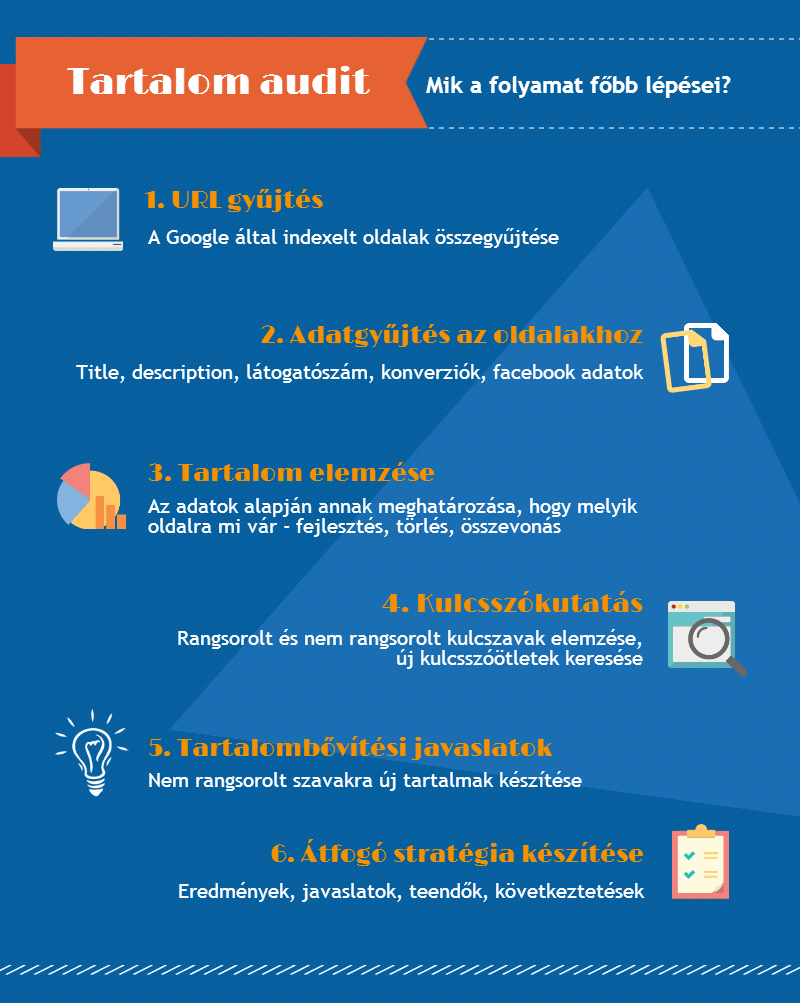Online content strategy and steps | Weboptim
Content audit is a qualitative analysis of the data on a websitei: to evaluate the content, we collect URLs and assign the necessary data, which is then analysed. It seems simple, but it's not. However, it has countless advantages when you do it.
Going through the process can help you determine:
- which pages need to be improved/updated/removed,
- which contents overlap,
- which content is the most valuable (e.g. in terms of number of visitors, conversions, trust index),
- where there are untapped content marketing opportunities,
- which keywords and content rank for in organic searches,
- and much more. 🙂

Let's look at the process step-by-step:
Choosing the strategy
based on 2 main factors, these are website size (number of pages indexed) and the risk of content-based penalties. If the page is at risk of being penalised, then the Panda algorithm should be taken into account - either improve the content or remove it. The size of the page will determine which of the two options is given more weight.
For smaller sites, keyword research is often needed to determine whether the content covers all the necessary aspects of the topic. For larger sites, however, it can be a problem if pages cover overlapping topics, so some of the content may be low quality/duplicated/outdated.
There are 3 main aspects of the penalty: quality - duplication - relevance. Google can penalise you for content if:
- poor quality (grammatical errors, keyword clusters),
- irrelevant,
- short (little text, many pictures),
- brought over from other sites (almost all parts exist on other websites),
- the optimisation is misleading (not informing the visitor properly),
- duplicated (within a page or on external pages),
- truncated (no content completed),
- contains too many labels.
Scan indexed pages and import data
To examine the pages, we need to collect the URLs that Google is counting. Several programs can help you do this, such as Screaming Frog. But URLs are worth nothing without the data they contain. The key performance indicators (KPIs) can be assigned to pages using different software.
By exporting the metrics to a worksheet, you can easily identify patterns, immediate opportunities and make decisions about how to manage individual pieces of content and the content of the website as a whole.

It can contain a variety of data, such as the type of page, meta title - meta description, facebook data. You may want to include a what to do column, in which we describe what the site is waiting for - removal, improvement, enhancement, or staying as it is. We also indicate the strategy, i.e. the way in which we want the job to be done.
Keyword research and analysis
You can use several methods to collect keywords, such as Adwords' keyword planner, Google Trend data, etc. Once collected, you need to filter out irrelevant keywords and then determine search traffic metrics for the rest.
A Google Webmaster Tool to get the search terms for which your website has appeared, as well as those through which visitors have actually reached the website (for larger websites, this step can be skipped).
Analysing data and preparing the strategy
Once you have all the information, put it into an excel spreadsheet, the analysis can begin. Based on the data, a decision must be made as to whether:
- Which pages should rewrite?
- Which pages should remove from in order to reduce the risk of a penalty?
- Is there stolen content on the remaining pages?
- By number of visits and searches:
- which pages need to be fixed? - e.g. high number of visitors but low page views
- which pages should be merged? - e.g. canonical tag, or 301 redirect
- which pages should be removed? - e.g. due to low quality/irrelevant content
- which pages will remain unchanged? - e.g. good visitor numbers, good conversion rates
We still need to figure out how to fill in the content gaps. We can think about creating new content or improving an existing but less performing one.
Once all the data has been analysed, the last step is to prepare the content strategy. This document contains the findings and recommendations collected and summarised during the audit.
Source: moz.com